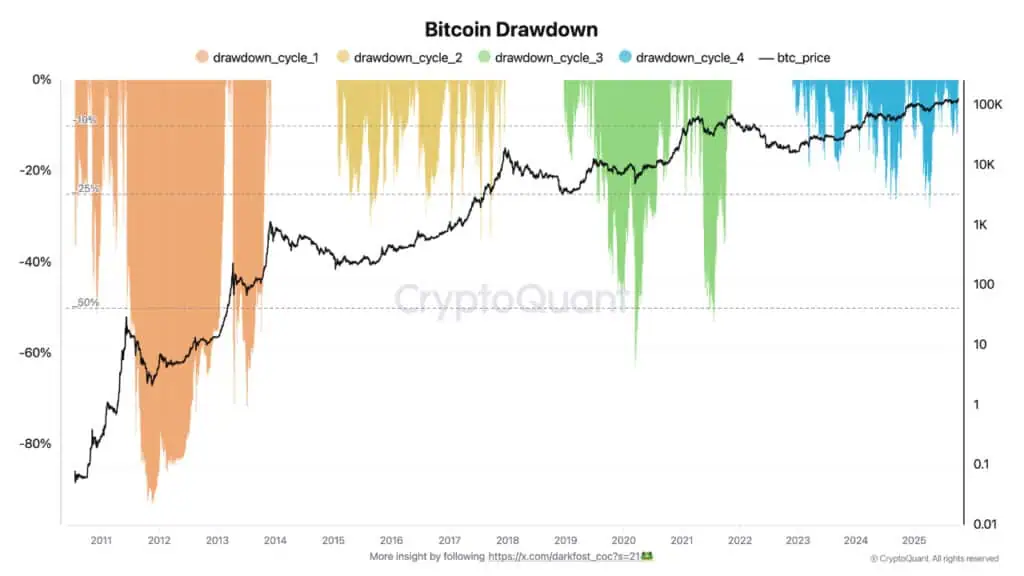
Bitcoin's fourth cycle is showing unprecedented signs: lower volatility, milder corrections, and a market transformed by the entry of large institutions and clearer regulations.
Unlike previous cycles, characterized by abrupt declines and explosive recoveries, Bitcoin's so-called "cycle 4" is exhibiting behavior that is disconcerting analysts and investors. The big question circulating in forums, specialized media, and financial firms is whether this time the historical pattern of 80% or 90% drops will repeat itself, or if we are facing a completely different scenario.
Data compiled by industry analysts, including reports from Glassnode and CoinMetrics, suggests that the current market is being built on different foundations. Volatility, which for years was Bitcoin's trademark, has been significantly reducedAnd with it, the corrections that used to sow panic among retail investors have also moderated.
Trade BTC here and take advantage of the market's maturityA different Bitcoin cycle, with fewer shocks
In previous cycles, especially between 2020 and 2022, Bitcoin experienced drops close to 50% on several occasions, even during bullish phases. This dynamic reinforced the perception that the asset was a high-risk territory, where quick gains could evaporate in a matter of weeks. However, in the current cycle, the story is different.
So far, the deepest correction has barely reached 28%. According to CryptoQuant analysts, most BTC pullbacks have remained in the 10% to 20% range, figures that, although significant, are much more manageable for investors. According to the data, the 25% threshold has only been exceeded on four occasions, making this cycle the least volatile in Bitcoin's history so far.

The Bitcoin market is going through a phase that many analysts interpret as a sign of maturity. Technical indicators, especially the Bollinger Bands, show a constant narrowing, a classic sign that volatility is decreasingIn practice, this translates into more contained price movements: neither declines nor bullish impulses are as aggressive as before. The market seems to have left behind the roller coaster of shocks that defined Bitcoin for much of its history.
This behavior marks a significant shift in the narrative that has accompanied the cryptocurrency for more than a decade. What was once synonymous with absolute unpredictability is now beginning to show signs of stability. This transformation not only affects market perception but also the way investors, both institutional and retail, interact with Bitcoin. Instead of viewing it as a risky asset, they are increasingly considering it as an asset that behaves with a more predictable and, in many cases, more mature logic.
Manage your Bitcoin on Bit2Me safely and securely.Institutions take the helm: This is how Bitcoin's fourth cycle is changing
The behavior of Bitcoin's fourth cycle cannot be understood without looking at who is behind the capital movements. In the early years, the market was dominated by retail investors and high-risk tech enthusiasts. Today, the picture is different.
The entry of large financial institutions, investment funds, and corporate treasuries has transformed the market structure. In the United States, the approval of Bitcoin-linked financial products and greater regulatory clarity have opened the door to players that previously remained on the sidelines. These new entrants, with greater capacity to absorb massive sell-offs, are reducing the pressure that used to cause abrupt crashes.
The result is a deeper and more liquid market, where traditional "whales"—those early investors with large amounts of BTC—no longer have the same power to move the price with a single transaction. Institutions now act as a counterweight, stabilizing fluctuations and providing a degree of predictability that previously seemed impossible.
Adoption also plays a key role. More and more businesses, platforms, and financial services are integrating Bitcoin into their operations, expanding their user base and reinforcing the perception that it is an asset with utility beyond speculation. This process, coupled with more favorable regulation in strategic markets, is consolidating a different environment than that seen in previous cycles.
Hold BTC and be part of the most stable cycle in historyThe new face of the Bitcoin market
Bitcoin's fourth cycle, following the network halving in 2024, is already distinguished from previous ones by its lower volatility, smoother corrections, and the presence of new players bringing stability. However, the big question remains: Will this be the first cycle to definitively break with the tradition of extreme falls?
Some analysts argue that, sooner or later, the market will once again show its tougher side. They argue that Bitcoin's speculative nature hasn't disappeared and that the history of financial assets is full of episodes where calm precedes unexpected storms. Others, however, believe that the maturing of the ecosystem, the influx of institutional capital, and growing adoption mark a turning point toward a more stable and sustainable market.
In their recent publication, CryptoQuant analysts assure that “This cycle is already different in both its structure and its dynamics.” and that “It no longer resembles the early Bitcoin cycles.” This indicates that the leading cryptocurrency is evolving before the eyes of investors and is now considered a strategic asset, traded on the trading desks of large funds, appearing on the balance sheets of multinational companies, and discussed in the parliaments of major economies.
So, while the outcome of this cycle remains to be seen, it's clear that Bitcoin is transforming before the eyes of the world, and that evolution will shape the course of cryptocurrencies over the next decade.
Buy BTC Today: The 4th Cycle Redefines the Crypto Narrative


